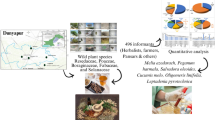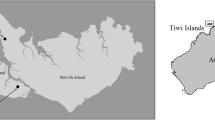Résumé
Dans son mémoire 2005,Les Malvacées en Phytothérapie, l’auteur fait une revue des utilisations traditionnelles et des études les plus récentes portant sur la famille des Malvacées. Dans l’extrait ci-dessous, il résume les données concernant les plantes du genre Hibiscus.
Abstract
In his 2005 dissertation,Les Malvacées en-Phytothérapie (The Malvaceae in Phytotherapy), the author reviews the traditional uses and the most recent studies about the Malvaceae family. In the extract below, the author summarizes the data concerning plants of the Hibiscus genus.
Similar content being viewed by others
Bibliographie
Adhirajan N,et al. (2003)In vivo andin vitro evaluation of hair growth potential ofHibiscus rosa-sinensis Linn. J Ethnopharmacol 88 (2–3): 235–9
Allorge-Boiteau L, Boiteau P (1993) Plantes médicinales de Madagascar. ACCT, ICSN CNRS, Karthala
Ames J. M.et al. Macleod G(1990) Volatile components of Okra. J Phytochemistry 29 (4): 1201–7
Batina M. de F. C.et al. (1997) J. Venon. Anim. Toxins 3 (1)
Botineau M (2003) Les plantes du jardin médiéval. Belin, Paris
Boulard B (2001) Dictionnaire des plantes médicinales du monde. Réalités et croyances, Éditions ESTEM
Bruneton J (1999) Pharmacognosie Phytochimie Plantes médicinales Tec dition. Éditons médicales internationales, Paris
Camciuc M.et al. (1998) Volatile components in okra seed coat. J Phytochemistry 48 (2): 311–315
Chang YC (2000)Hibiscus anthocyanins rich extract-induced apoptotic cell death in human promyelocytic leukemia cells. Taiwan. J Biochemical Pharmacology 60 (3): 307–315
Chin F (1986) The Hibiscus, Queen of Tropical Flowers. Tropical Press SDN.BHD Kuala Lumpur, Malaysia
Dugué P, Bel J, Gomez-Figueredo M (1990) Allergie professionnelle à l’Ambrette: cinq observations dans l’industrie de la parfumerie. J Revue fr d’allergologie et d’immunologie clinique 30 (1): 29–31
El- Saadany,et al. (2005) Biochemical dynamics and hypocholesterolemic action ofHibiscus sabdariffa (Karkade). J Pakistan Journal of Nutrition 4 (3): 135–141
Frawley, David and Vasant Lad (1986) The Yoga Of Herbs: An Ayurvedic Guide to Herbal Medicine. Santa Fe: Lotus Press
Gunther R (1959) The Greek Herbal of Dioscorides. New York
Gurbuz I,et al. (2003) Anti-ulcerogenic activity of some plants used as folk remedy in Turkey. J Ethnopharmacol 88 (1): 93–97
Gurib-Fakim B (2004) Medicinal and Aromatic Plants of Indian Ocean Islands. Medpharm Scientific Publishers, 279–281. Stuttgart
Kaptchuk TJ (1986) 1989 Jade Pharmacy. Satas, Bruxelles
Kharre CP (2004) Indian Herbal Remedies. Rational Western Therapy, Ayurvedic and Other Traditional Usage, Botany. Springer-Verlag, Berlin
Kokwaro JO (1976) Medicinal Plants of East Africa. General Printers Nairobi, Kenya
Lavergne R (1999) Le grand livre des tisaneurs et plantes médicinales indigènes de la Réunion. Orphie
Lengsfeldet al. (2004) Glycosylated compounds from okra inhibit adhesion of Helicobacter pylori to human gastric mucosa, J Agric Food Chem 52(6): 1495–50
Liu JY et al (2004) Taïwan
Nivsarkar M.et al. (2005) Blastocyst implantation failure in mice due to “nonreceptive endometrium”: endometrial alteration byHibiscus rosa sinensis leaf extract. J Contraception 71(3): 227–230
Trivedi V. Et Shukla K. J. (1980) J Sci. Res. Pl. Med. 1(3–4): 41–47
Neuwinger HD (1996) African Ethnobotany, Poisons & Drugs. Chapman & Hall
Pakrashi A.et al. (1986) Flowers ofHibiscus rosa sinensis, a potential source of contragestative agent III: interceptive effect of benzene extract in mouse. Calcutta, Inde. J Contraception 34(5): 523–536
Pinkas M, Peng W, Torck M, Trotin E (1996) Plantes médicinales chinoises. Maloine, Paris.
Roi J (1955) Traité des plantes médicinales chinoises. Paul Lechevalier, Paris
Tseng HD (2003) Induction of apoptosis by hibiscus protocatechuic acid in human leukemia cells via reduction of retinoblastoma (RB) phosphorylation and Bcl-2 expression. Biochem Pharmacol 60(3), 1 aug. 2000
Usoh IF et Akapan EJ,et al. (2005) J Pak Jour Nutri 4(3): 135–141
Yoo ID,et al. (1998) Three naphthalenes from root barkof Hibiscus syriacus. Phytochemistry 47(5): 799–802
Zhang EJ, Kang QS, Zhang Z (1993) Chemical constituents from the barkof Hibiscus syriacus L., ZhongguoZhong Yao Za Zhi Jan 18(1): 37–8, 63
Flore du Mozambique (1987) Gouvernement du Mozambique
Author information
Authors and Affiliations
Corresponding author
About this article
Cite this article
de La Ripelle, H.F. Les hibiscus, tradition et modernité. Phytothérapie 4, 136–144 (2006). https://doi.org/10.1007/s10298-006-0168-4
Published:
Issue Date:
DOI: https://doi.org/10.1007/s10298-006-0168-4
Mots clés
- Hibiscus Rose de Chine (Hibiscus rosa sinensis L.)
- Okra (Hibiscus esculentus L.)
- Hibiscus « Caprice-de-femme » (Hibiscus mutabilis L.)
- Mauve de Syrie (Hibiscus syriacus L.)
- Karkadé (Hibiscus sabdariffa L.)
- Ambrette (Hibiscus abelmoschus L.)
- Hibiscus calyphyllus Cav.
- Chanvre de Guinée (Hibiscus cannabinus L.)
- Hibiscus fuscus Garcke
- Hibiscus surattensis L.
- Hibiscus boryanus DC
- Hibiscus columnaris Cav.
- Utilisations traditionnelles
- Études récentes
Keywords
- Chinese hibiscus (Hibiscus rosa sinensis L.)
- Okra, Lady’s finger (Hibiscus esculentus L.)
- Changeable Rose Mallow (Hibiscus mutabilis L.)
- Rose of Sharon (Hibiscus syriacus L.)
- Sour tea (Hibiscus sabdariffa L.)
- Ambrette (Hibiscus abelmoschus L.)
- Hibiscus calyphyllus Cav.
- Hibiscus cannabinus L.
- Hibiscus fuscus Garcke
- Hibiscus surattensis L.
- Hibiscus boryanus DC
- Hibiscus columnaris Cav.
- Traditional uses
- Recent studies




